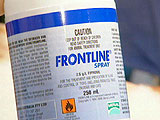Tick Season
Veterinary surgeon Dr Rob Zammit had a timely warning for pet owners living in areas where ticks are found (along the whole of the east coast from north Queensland to northern Victoria, and inland when conditions are favourable). It is very important to understand that a bite from the Australian paralysis tick (Ixodes holocyclus) can kill your pet. Animals bitten by a tick first become paralysed at the base of the spine. The paralysis gradually works its way to the nerves supplying the diaphragm, and the pet dies of respiratory failure. This year conditions are particularly good for ticks, and we are now at the height of the tick season. In the 72 hours before filming our segment, Rob treated 7 patients with ticks embedded in their skin.
What to do
Use one of the tick control products available on the market. Rob has found Verbac tick collars particularly good, or you might try a spray such as Frontline. Sprays have to be applied every couple of weeks. Some products are unsuitable for young kittens and puppies, so make sure you follow the advice of your vet.
Check your cat or dog every day for ticks. This is simply a matter of running your fingers over the whole of the animal’s body and investigating any unusual lump. If you do find a tick, take the dog or cat to the vet immediately. If for some reason you can’t get to a vet, dab the tick with insecticide so that it becomes drowsy and releases its grip. Then pluck the tick off and keep it in a bottle for identification. Take your pet to the vet as soon as possible, along with the bottled tick.
Further information
Tick control products, including Frontline spray and Verbac Preventic collars, are available from your local veterinary clinic. Prices vary depending on whether you have a dog or cat, and its body weight.



